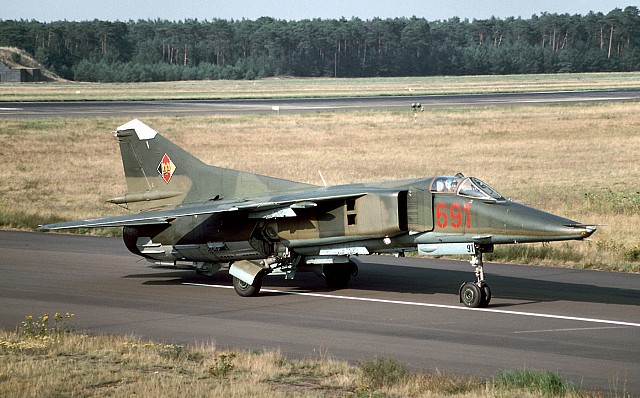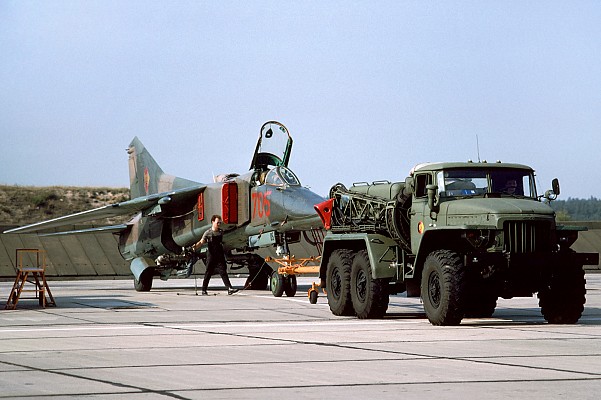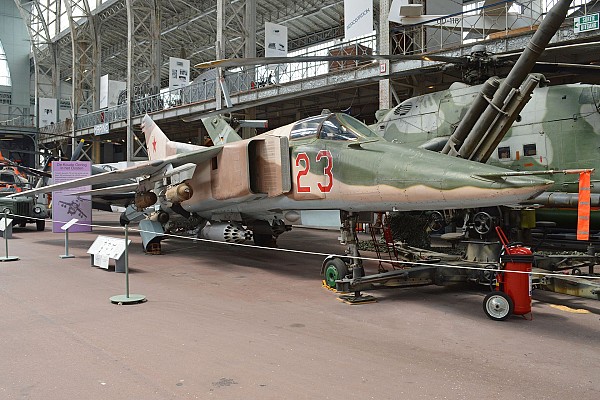Mikoyan MiG-23BN
NATO: Flogger F/H
Introduction

MiG-23BN
East German MiG-23BN belonging to JBG-37 seen in 1990.
Source: Rob Schleiffert -
© CC BY-SA 2.0
1971 - 1972 (MiG-23BN)
1973 - 1985 (MiG-23BN)
624 MiG-23BN
Model 32-24 (industry code)
Syria
Description
Introduction
The MiG-23BN is a late Cold War era ground attack fighter of Soviet origin. It was developed to meet Soviet requirements for a new generation of new ground attack fighter. The Mikoyan design bureau was looking at a new design, but budget restraints and requirement to deliver soon drove the design towards the MiG-23 that was on the production line. In time the MiG-23BN was further developed in the MiG-27, which has a different nose with much improved visibility in the air to ground role.
Design
The MiG-23BN is based on the MiG-23ML fighter aircraft. The radar is replaced with a targeting and navigation system for a wide range of air to ground ordnance. The layout of the hardpoints is a bit different with two fuselage hardpoints and all six capable of 500 kg payload. The pre-production batch of MiG-23B had the AL-21F-3 engine and older Sokol-23S. The main production MiG-23BN model has the R-29B-300 engine, which was only slightly derated compared to the fighter variants. This allows the MiG-23BN to carry out a low level supersonic dash.
Sensors
The MiG-23BN is fitted with the Sokol-23N sighting and navigation system. There is no radar system.
Firepower
The MiG-23BN has six hardpoints: two fuselage, two wing glove and two wing pylons. Total capacity is 2 t of external stores. Armament consists of dumb bombs of up to 500 kg, R-13M and R-60 infrared guided air to air missiles, 57mm S-5 aerial rockets and the Kh-23 Grom (NATO: AS-7 Kerry) air to surface missile. Internal armament consists of a double barrel 23mm GSh-23L autocannon with 200 rounds.
Mobility
The MiG-23BN can operate from austere airfields. The variable geometry wings allow for a limited take-off and landing run, while being capable of sustained supersonic flight at high altitude. The MiG-23BN is also capable of temporary supersonic speed at sea level, increasing its survivability near the target area. Ferry range is 1.350 km and combat range is 550 km with a high-low-high flight pattern.
Users
The MiG-23BN was adopted by Soviet frontal aviation and exported to many nations with close ties to the USSR. The MiG-23BN was extensively used in various conflicts in the Middle East. Iraq used the type throughout the Iran-Iraq war.
Variants

MiG-23BN
East German MiG-23BN with Ural fuel truck in front.
Source: Rob Schleiffert -
© CC BY-SA 2.0
Variants of the MiG-23BN ground attack aircraft
Details
Weapon options

MiG-23BN
Former Egyptian Air Force MiG-23BN on display in a museum in Brussels.
Source: Alan Wilson -
© CC BY-SA 2.0